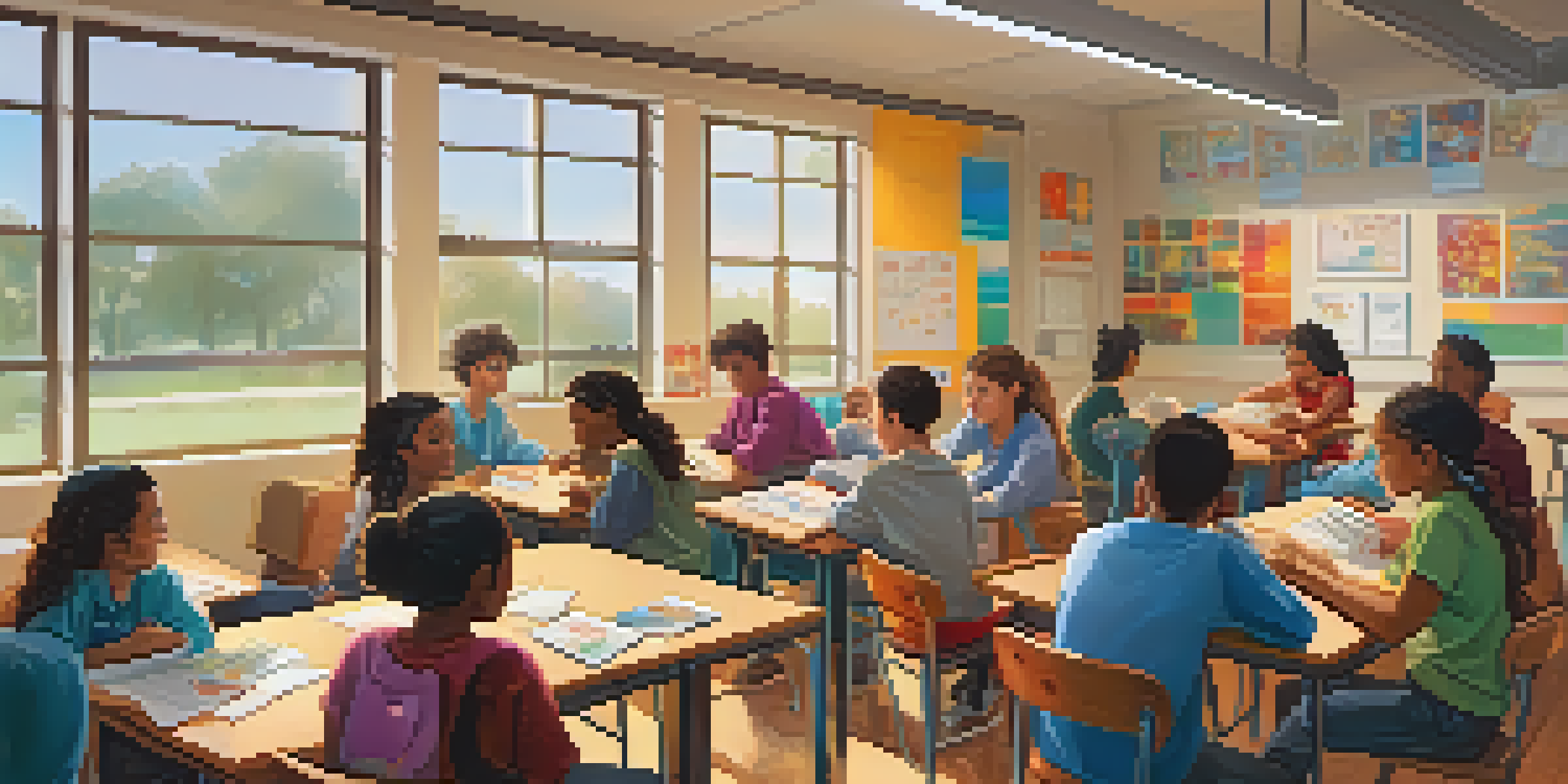The Role of Teachers in Facilitating Peer Learning

Understanding Peer Learning and Its Benefits
Peer learning is an educational approach where students learn from each other. This method not only enhances academic performance but also builds critical social skills. When students collaborate, they engage in discussions that deepen their understanding of the subject matter.
Tell me and I forget, teach me and I remember, involve me and I learn.
For instance, a study group tackling a complex math problem can lead to various solutions, each reinforcing different concepts. This collaborative effort helps students retain information better and develop a sense of community. The benefits extend beyond academics, fostering teamwork and communication skills.
Moreover, peer learning can cater to diverse learning styles. Some students may grasp concepts more effectively when explained by their peers rather than through traditional teaching methods. This adaptability makes peer learning a powerful tool in the classroom.
Teachers as Facilitators of Peer Learning
Teachers play a crucial role in facilitating peer learning by creating a supportive environment. They guide students in forming study groups and encourage them to share their knowledge and insights. This involves setting clear expectations and providing the necessary resources for effective collaboration.

For example, a teacher might introduce structured activities that promote group discussions or peer teaching sessions. By doing so, they help students feel more comfortable engaging with one another. This support is vital in ensuring that all voices are heard and valued in the learning process.
Peer Learning Enhances Skills
Peer learning not only boosts academic performance but also fosters essential social skills like teamwork and communication.
Additionally, teachers can monitor group dynamics and provide feedback, ensuring that the learning remains productive. Their presence helps to foster an atmosphere of trust, where students feel safe to express their ideas and ask questions.
Encouraging Collaboration Through Group Activities
Group activities are a cornerstone of peer learning, and teachers can enhance these experiences. By designing engaging tasks that require collaboration, teachers motivate students to work together. These activities can range from project-based learning to group discussions on relevant topics.
Learning is not the product of teaching. Learning is the product of the activity of learners.
For instance, in a literature class, students might be assigned to work in pairs to analyze different characters in a novel. This not only promotes critical thinking but also encourages them to articulate their thoughts and listen to others. Through such interactions, students develop a deeper understanding of the material.
Moreover, collaborative activities help students learn to navigate conflicts and negotiate ideas. These are essential life skills that extend beyond the classroom, preparing students for future teamwork in their careers.
Fostering a Growth Mindset in Peer Learning
A growth mindset is the belief that abilities can be developed through dedication and hard work. Teachers can cultivate this mindset among students, encouraging them to view challenges as opportunities for growth. This perspective is vital in peer learning, where students often encounter difficulties.
For example, a teacher might share stories of famous individuals who overcame failure to achieve success. By normalizing struggle, students are more likely to support each other during tough times. This creates a culture where asking for help is seen as a strength, not a weakness.
Teachers Facilitate Collaboration
Teachers play a vital role in guiding peer learning by creating supportive environments and structuring group activities.
Additionally, teachers can model resilience by sharing their learning journeys. When students see that their teachers also face challenges, it fosters a sense of camaraderie and encourages them to embrace peer learning as a valuable tool for personal development.
Assessing Peer Learning Effectively
Assessment is key in any educational setting, and peer learning is no exception. Teachers must find ways to evaluate both individual contributions and group dynamics. This could include self-assessments, peer evaluations, and reflective journals that encourage students to think critically about their collaborative experiences.
For instance, a teacher might have students rate their peers on participation and support during a project. This feedback not only informs the teacher but also helps students understand the importance of accountability in group work. It reinforces the idea that everyone's contribution matters.
Furthermore, regular check-ins can help teachers gauge the effectiveness of peer learning. By asking students about their experiences, teachers can make informed adjustments to enhance future collaborative efforts.
Creating Inclusive Peer Learning Environments
Inclusivity is essential for effective peer learning, and teachers must strive to create an environment where all students feel welcome. This involves recognizing and valuing diverse backgrounds, abilities, and perspectives. Teachers can achieve this by implementing varied group compositions and ensuring everyone has a role.
For example, a teacher might intentionally pair students with different strengths together. This not only allows them to learn from each other but also fosters respect for diverse approaches. When students see the value in each other's contributions, it leads to a more harmonious learning environment.
Inclusivity Drives Effective Learning
Creating inclusive peer learning environments helps students appreciate diverse perspectives, enriching the overall educational experience.
Moreover, teachers should encourage open dialogue about inclusivity. By discussing biases and promoting empathy, they help students develop a deeper understanding of their peers. This cultural sensitivity enriches the peer learning experience, making it more impactful.
The Long-Term Impact of Peer Learning on Students
The benefits of peer learning extend far beyond the classroom, influencing students' long-term development. Skills such as collaboration, communication, and critical thinking are invaluable in both personal and professional realms. As students become adept at learning from their peers, they cultivate a lifelong love of learning.
For instance, many employers today value teamwork and interpersonal skills. Students who engage in peer learning are better prepared to navigate the complexities of a collaborative work environment. They emerge as confident individuals who can articulate their ideas and listen to others.

Ultimately, peer learning nurtures resilient learners who are comfortable taking risks. This adaptability is crucial in an ever-changing world, equipping students with the tools they need to thrive in various aspects of life.